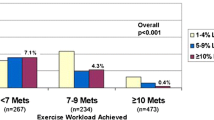Abstract
Purpose
Nuclear cardiology is a well-validated, non-invasive imaging modality that is highly cost-effective as a diagnostic and prognostic tool in the evaluation of patients with known or suspected coronary artery disease. However, the number of procedures in Europe is very far from that which would be expected on the basis of epidemiological data, particularly when comparison is made with the USA. As a preliminary step for future action aimed at improving and increasing nuclear cardiology practice in Europe, the European Council of Nuclear Cardiology performed a survey to identify the regulatory issues and the training components pertaining to the practice of nuclear cardiology.
Methods
a questionnaire was sent to 31 national nuclear medicine societies and to 40 national cardiology societies. The main areas covered by the survey were: (1) the license requirements, (2) the theoretical and practical aspects of training and (3) supervision of the stress test during a nuclear cardiology study.
Results
The results show that, in a setting of wide heterogeneity of national regulations, education and professional practice, nuclear medicine is a restricted and closely regulated specialty. This situation guarantees the quality and safe use of radionuclides; at the same time, however, it limits integration of nuclear medicine into the clinical arena.
Conclusion
Cardiologists should become more involved in nuclear cardiology, to further stimulate the use of this powerful diagnostic and prognostic imaging modality.

Similar content being viewed by others
References
ACC/AHA/ASNC. Guidelines for the Clinical Use of Cardiac Radionuclide Imaging—Executive Summary: A report of the American College of Cardiology/American Heart Association Task Force on Practice Guidelines. J Am Coll Cardiol 2003;42:1318–1333
American Society of Nuclear Cardiology. Updated imaging guidelines for nuclear cardiology procedures, Part 1. J Nucl Cardiol 2001;8:G5–52
American Society of Nuclear Cardiology. Imaging guidelines for nuclear cardiology procedures: Part 2. J Nucl Cardiology 1999;6:G49–G84
Mowatt G, Vale L, Brazzelli M, Hernandez R, Murray A, Scott N, et al. Systematic review of the effectiveness and cost-effectiveness, and economic evaluation, of myocardial perfusion scintigraphy for the diagnosis and management of angina and myocardial infarction. (http://www.nice.org.uk/pdf/Scintigraphy_Assessment_Report.pdf)
Brindis RG, Douglas PS, Hendel RC, Peterson ED, Wolk MJ, Allen JM, et al. ACCF/ASNC appropriateness criteria for single-photon emission computed tomography myocardial perfusion imaging (SPECT MPI): a report of the American College of Cardiology Foundation Quality Strategic Directions Committee Appropriateness Criteria Working Group and the American Society of Nuclear Cardiology. J Am Coll Cardiol 2005;46:1587–1605
Union Européene des Medécins Spécialistes, Section of Nuclear Medicine, European Board of Nuclear Medicine, Syllabus for postgraduate specialisation in Nuclear Medicine, 2002 Update (http://www.eanm.org)
Nuclear Cardiology in Europe. National Variation in Education and Legislation (http://www.ecnc-nuclearcardiology.org/index.php)
Acknowledgement
The authors thank Susanna Wiener, PhD, for her invaluable assistance in all phases of this project.
Author information
Authors and Affiliations
Corresponding author
Additional information
On behalf of the European Council of Nuclear Cardiology
Appendix: survey structure
Appendix: survey structure
-
1.
Is nuclear medicine a specialty by itself?
-
2.
-
a)
What is the training to become a nuclear medicine specialist?
-
b)
Is there specific training for nuclear cardiology?
-
a)
-
3.
Who is allowed to practice nuclear medicine?
-
4.
-
a)
Is a licence required to order and/or to inject radiopharmaceuticals?
-
b)
Do specialists other than NM specialists have the possibility:
to obtain a full licence?
to obtain a restricted licence?
to engage in restricted practice?
-
a)
-
5.
Is it possible to acquire the specialty of nuclear medicine as a second specialty?
-
6.
Is a physician required to be present at the performance of a stress test?
-
7.
Are nuclear medicine specialists allowed to perform stress tests on patients?
If yes, is specific training required?
Rights and permissions
About this article
Cite this article
Marcassa, C., Bischof Delaloye, A., Cuocolo, A. et al. The regulatory background of nuclear cardiology in Europe: a survey by the European Council of Nuclear Cardiology. Eur J Nucl Med Mol Imaging 33, 1508–1512 (2006). https://doi.org/10.1007/s00259-006-0211-6
Published:
Issue Date:
DOI: https://doi.org/10.1007/s00259-006-0211-6




